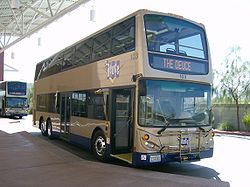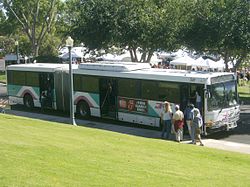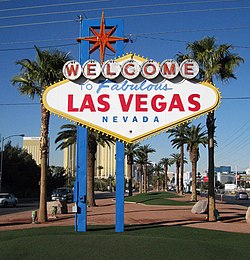| Route | Name | Termini [a] | via | Notes / Refs. | Length |
|---|
| 100s: Local (Residential) Routes, North/South |
| 101 | Rainbow | Lone Mtn & Rancho (N) | Rainbow & Blue Diamond (S) | Rainbow | | 16.7 miles (26.9 km) |
|---|
| 102 | Jones | Craig & Rancho (N) | Jones & Robindale (S) | Jones | | 16.3 miles (26.2 km) |
|---|
| 103 | Decatur | Grand Teton & Decatur | Decatur & Blue Diamond (S) | Decatur | Route split as 103A/103B; 103A runs east on northern end, 103B runs less frequently west on northern end via Jones, 24-hr service from Deer Springs to Sunset (As route 103) | 20.8 miles (33.5 km) (103A) |
|---|
| Decatur & Elkhorn | 22.8 miles (36.7 km) (103B) |
| 104 | Valley View | Tenaya & Mtn View Hospital (N) | SSTT (S) | Torrey Pines, Washington, Valley View, Russell, and Las Vegas Blvd | Some southbound trips continue as 117 or 122 | 16.5 miles (26.6 km) |
|---|
| 105 | Martin L. King | N. 5th & Rome (N) | BTC (S) | Tropical, Camino Eldorado, Camino Al Norte, Martin Luther King | 24-hr service | 11.4 miles (18.3 km) |
|---|
| 106 | Rancho / Centennial Hills | CHTC (N) | Rancho, Bonanza, and Main | Route split as 106A/106B; 106A runs counter-clockwise at north end, 106B runs clockwise | 17.3 miles (27.8 km) 106A |
|---|
| 17.4 miles (28.0 km) 106B |
| 108 | Paradise | BTC (N) | Reid Airport (Terminal 1, Level 0) (S) | Paradise / University Center | | 6 miles (9.7 km) |
|---|
| 109 | Maryland Pkwy | SSTT (S) | Maryland Pkwy, Reid Airport (Terminal 1, Level 0) | 24-hr service | 10.5 miles (16.9 km) |
|---|
| 110 | Eastern | Cheyenne & Civic Ctr (N) | Eastern & Horizon Ridge (S) | Jones | 24-hr service | 17.8 miles (28.6 km) |
|---|
| 111 | Green Valley / Pecos | Pecos & Craig (N) | Green Valley Ranch Resort (S) | Pecos | Route split as 111A/111B south of Sunset; A serves Pecos, while B serves Green Valley Parkway | 17.4 miles (28.0 km) 111A |
|---|
| 17.7 miles (28.5 km) 111B |
| 113 | Las Vegas Blvd N | Las Vegas Blvd & Craig (N) | BTC (S) | Las Vegas Blvd N | Alternate trips serve each terminal; 24-hr service south of Craig | 8.5 miles (13.7 km) |
|---|
| Sloan & El Campo Grande (N) | 10.8 miles (17.4 km) |
| 115 | Nellis / Stephanie | Craig & N Las Vegas Blvd (N) | Stephanie & Horizon Ridge (S) | Nellis and Stephanie | 24-hr service north of Tropicana | 18 miles (29 km) |
|---|
| 117 | Las Vegas Blvd. S. / Silverado Ranch | SSTT (N/W) | Eastern & Serene (S/E) | Las Vegas Blvd (N/S) & Silverado Ranch (E/W) | Many N/W-bound routes continue as 217 (fewer as 104 or 122) | 9 miles (14 km) |
|---|
| 119 | Simmons / Koval | Elkhorn & Aliante Pkwy (N) | Reno & Las Vegas Blvd (S) | Simmons, Rancho Tonopah, Sammy Davis Jr, and Koval | | 16.1 miles (25.9 km) |
|---|
| 120 | Fort Apache / Rampart | Durango/Rampart & Cheyenne (N) | Durango & Blue Diamond (S) | Rampart and Fort Apache | Most southbound routes continue as 121 | 15.4 miles (24.8 km) |
|---|
| 121 | Durango / Buffalo | Buffalo & Cheyenne (N) | Buffalo and Durango | Most southbound routes continue as 120 | 15.1 miles (24.3 km) |
|---|
| 122 | S. Maryland Pkwy / W. Henderson | SSTT (N) | Las Vegas Blvd & Volunteer (S) | Paradise, Maryland Parkway, and St. Rose Parkway | Most weekend/holiday northbound routes continue as 217. Others continue as 104, 109, or 117. | 11.8 miles (19.0 km) |
|---|
| Route | Name | Termini [a] | via | Notes / Refs. | Length |
|---|
| 200s: Local (Residential) Routes, East/West |
| 201 | Tropicana | Tropicana & Fort Apache (W) | Andover (E) | Tropicana | Split as 201A/201B; 201A runs along Tropicana, while 201B has western loop on Russell
24-hr service (201A only) | 15.9 miles (25.6 km) 201A |
|---|
| 20 miles (32 km) 201B |
| 202 | Flamingo | Grand Canyon & Rochelle (W) | Harmon & Boulder Hwy (E) | Flamingo | 24-hr service | 15.3 miles (24.6 km) |
|---|
| 203 | Spring Mountain / Desert Inn / Lamb | Town Center & Twain (W/S) | Lamb & Craig (E/N) | Desert Inn, Spring Mountain, and Lamb | | 23.8 miles (38.3 km) |
|---|
| 206 | Charleston | Pavilion Ctr & Summerlin Ctr (W) | Charleston & Sloan (E) | Charleston and BTC | Split as Blue and Gold; Blue runs abbreviated route between Rainbow and Nellis while Gold runs whole route, making limited stops between Rainbow and Nellis (currently suspended)
24-hr service | 17.5 miles (28.2 km) |
|---|
| 207 | Alta / Stewart | Alta & Rampart (W) | Stewart & Nellis (E) | Alta and Meadows | Most westbound routes continue as 209 | 15.8 miles (25.4 km) |
|---|
| 208 | Washington | WTC (W) | Bonanza & Nellis (E) | Washington and BTC | Some eastbound routes continue as 215 | 17 miles (27 km) |
|---|
| 209 | Vegas / Owens | Alta & Rampart (W) | Owens & Nellis (E) | Vegas Drive | Most westbound routes continue as 207 | 14.2 miles (22.9 km) |
|---|
| 210 | Lake Mead Blvd. | Town Center & Covington (W) | Lake Mead & Radwich (E) | Town Center and Lake Mead Blvd | 24-hr service | 17.4 miles (28.0 km) |
|---|
| 212 | Sunset | Fort Apache & Sunset (W) | Lake Mead & Center (E) | Sunset, Warm Springs, and SSTT | | 27.5 miles (44.3 km) |
|---|
| 214 | H Street / D Street | BTC | Main, D / H Streets | Loop service split as East (H St) and West (D St) | 12.2 miles (19.6 km) 214E |
|---|
| 10.1 miles (16.3 km) 214W |
| 215 | Bonanza | BTC (W) | Nellis & Bonanza (E) | Bonanza | | 6.2 miles (10.0 km) |
|---|
| 217 | Warm Springs / Lake Mead Pkwy. | Dean Martin / Silverton (W) | Boulder Hwy & Palo Verde (E) | Warm Springs, Lake Mead Pkwy, and SSTT | | 18.8 miles (30.3 km) |
|---|
| 218 | Cheyenne | Cheyenne & Hualapai (W) | Cheyenne & Nellis (E) | Cheyenne | | 15.4 miles (24.8 km) |
|---|
| 219 | Craig | Lone Mtn & Rancho (W) | Craig & Las Vegas Blvd (E) | Craig | | 11.4 miles (18.3 km) |
|---|
| 220 | Ann / Tropical | Skye Canyon Park & Grand Canyon (W) | Centennial & Hollywood (E) | Deer Springs, Ann, and Tropical | | 22.3 miles (35.9 km) |
|---|
| 221 | Cactus / Horizon Ridge / Boulder City | Durango & Blue Diamond (W) | Utah & Northridge (E) | Blue Diamond, Cactus, Carnegie, Horizon Ridge, and Boulder City | | 40.3 miles (64.9 km) |
|---|
| Route | Name | Termini [a] | via | Notes / Refs. | Length |
|---|
| 300s: "The Deuce" Strip Corridor Routes |
| Deuce | Deuce on The Strip | Fremont Street Experience (N) | SSTT (S) | Las Vegas Blvd and BTC | 24-hr service | 9.2 miles (14.8 km) |
|---|
| DTL | Downtown Loop | BTC | Symphony Park, LV North Premium Outlet, City Hall, Fremont Street Experience, Mob Museum, Arts District, The Strat | Free shuttle, operating primarily in the afternoons *owned and operated by the City of Las Vegas, not RTCSNV | 8.1 miles (13.0 km) |
|---|
| Route | Name | Termini [a] | via | Notes / Refs. | Length |
|---|
| 400s: Regular Shuttle Routes |
| 401 | N. Outlets / Symphony Park | BTC | Grand Central and Main | Service to Symphony Park, LV North Premium Outlet, Fremont Street Experience | 3 miles (4.8 km) |
|---|
| Route | Name | Termini [a] | via | Notes / Refs. | Length |
|---|
| 500s: Express routes |
| BHX | Boulder Highway Express | BTC (N) | CSN Henderson (S) | Fremont Street (Boulder Highway) | Split as BHX-A/BHX-B; BHX-A runs on Water and serves CSN, BHX-B serves NSC
24-hr service north of Horizon (BHX-A only) | 18.4 miles (29.6 km) BHX-A |
|---|
| Nevada State College (S) | 20.8 miles (33.5 km) BHX-B |
| CX | Centennial Express | Skye Canyon Park & Grand Canyon (N) | Reid Airport (Terminal 3) (S) | CHTC, Oran K. Gragson Freeway, BTC, Las Vegas Freeway, Flamingo Road, Maryland Parkway | | 31.3 miles (50.4 km) |
|---|
| DVX | Downtown & Veterans Medical Center Express | BTC (S) | VA Southern Nevada Healthcare System (N) | Las Vegas Freeway, Losee Road | | 12.8 miles (20.6 km) |
|---|
| SX | Sahara Express | Pavilion Ctr & Summerlin Ctr (W) | Nellis & Desert Inn (E) | Sahara Avenue | Split into SX-A/SX-B; SX-B runs on Vegas Valley
24-hr service west of Nellis (signed as SX-B eastbound and SX-A westbound) | 16.6 miles (26.7 km) |
|---|
| Vegas Valley & Hollywood (E) | 18.2 miles (29.3 km) |
|
























































